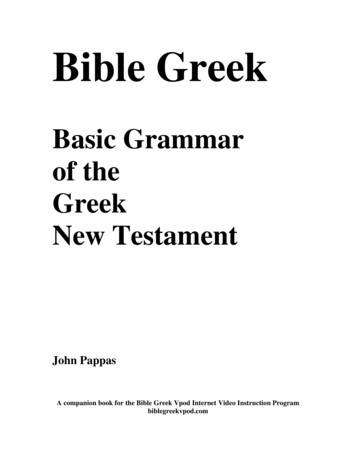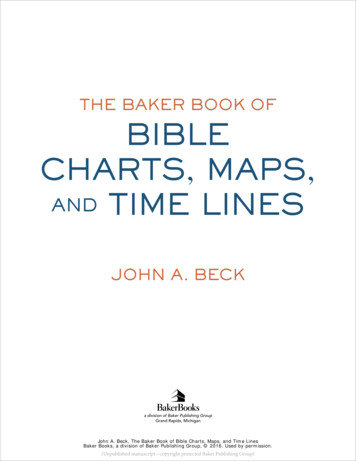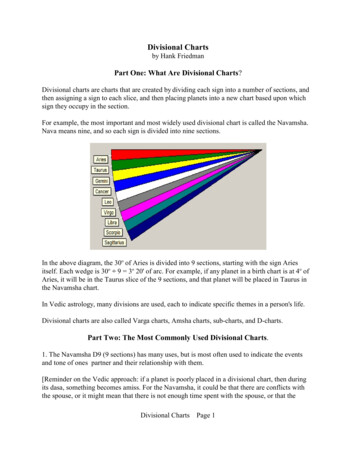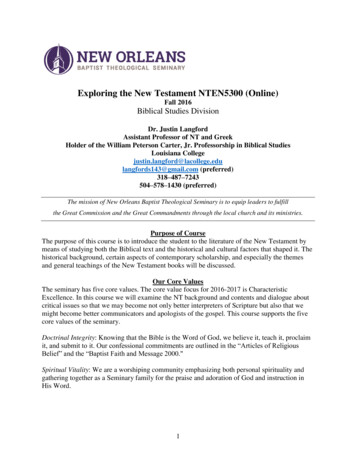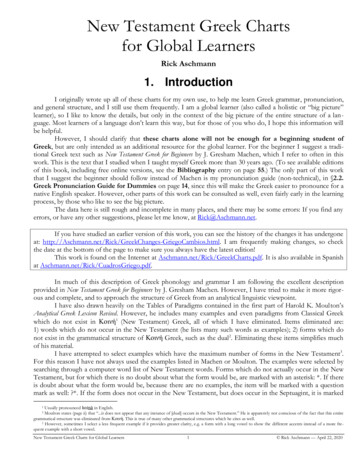
Transcription
New Testament Greek Chartsfor Global LearnersRick Aschmann1. IntroductionI originally wrote up all of these charts for my own use, to help me learn Greek grammar, pronunciation,and general structure, and I still use them frequently. I am a global learner (also called a holistic or “big picture”learner), so I like to know the details, but only in the context of the big picture of the entire structure of a language. Most learners of a language don’t learn this way, but for those of you who do, I hope this information willbe helpful.However, I should clarify that these charts alone will not be enough for a beginning student ofGreek, but are only intended as an additional resource for the global learner. For the beginner I suggest a traditional Greek text such as New Testament Greek for Beginners by J. Gresham Machen, which I refer to often in thiswork. This is the text that I studied when I taught myself Greek more than 30 years ago. (To see available editionsof this book, including free online versions, see the Bibliography entry on page 55.) The only part of this workthat I suggest the beginner should follow instead of Machen is my pronunciation guide (non-technical), in §2.2.Greek Pronunciation Guide for Dummies on page 14, since this will make the Greek easier to pronounce for anative English speaker. However, other parts of this work can be consulted as well, even fairly early in the learningprocess, by those who like to see the big picture.The data here is still rough and incomplete in many places, and there may be some errors: If you find anyerrors, or have any other suggestions, please let me know, at Rick@Aschmann.net.If you have studied an earlier version of this work, you can see the history of the changes it has undergoneat: s.html. I am frequently making changes, so checkthe date at the bottom of the page to make sure you always have the latest edition!This work is found on the Internet at Aschmann.net/Rick/GreekCharts.pdf. It is also available in Spanishat Aschmann.net/Rick/CuadrosGriego.pdf.In much of this description of Greek phonology and grammar I am following the excellent descriptionprovided in New Testament Greek for Beginners by J. Gresham Machen. However, I have tried to make it more rigorous and complete, and to approach the structure of Greek from an analytical linguistic viewpoint.I have also drawn heavily on the Tables of Paradigms contained in the first part of Harold K. Moulton’sAnalytical Greek Lexicon Revised. However, he includes many examples and even paradigms from Classical Greekwhich do not exist in Κοινή1 (New Testament) Greek, all of which I have eliminated. Items eliminated are:1) words which do not occur in the New Testament (he lists many such words as examples); 2) forms which donot exist in the grammatical structure of Κοινή Greek, such as the dual2. Eliminating these items simplifies muchof his material.I have attempted to select examples which have the maximum number of forms in the New Testament3.For this reason I have not always used the examples listed in Machen or Moulton. The examples were selected bysearching through a computer word list of New Testament words. Forms which do not actually occur in the NewTestament, but for which there is no doubt about what the form would be, are marked with an asterisk: *. If thereis doubt about what the form would be, because there are no examples, the item will be marked with a questionmark as well: ?*. If the form does not occur in the New Testament, but does occur in the Septuagint, it is markedUsually pronounced koinā in English.Moulton states (page ii) that “.it does not appear that any instance of [dual] occurs in the New Testament.” He is apparently not conscious of the fact that this entiregrammatical structure was eliminated from Κοινή. This is true of many other grammatical structures which he cites as well.3 However, sometimes I select a less frequent example if it provides greater clarity, e.g. a form with a long vowel to show the different accents instead of a more frequent example with a short vowel.12New Testament Greek Charts for Global Learners1 Rick Aschmann — April 22, 2020
with (S).4 If the form occurs in the Septuagint for a different word in the same class, it is marked with * (S). Formsmarked with two asterisks ** not only do not occur in the New Testament for this word, but no other comparableword has the form either. (These have been included only to complete the paradigms.)Numbers included in some of the tables refer to paragraph numbers in Machen’s book; elsewhere in thetext I will place the symbol ¶ before such paragraph numbers. I will also refer at times to Moulton’s book, thoughhis structure is not as simple as Machen’s: Roman numerals refer to sections, Arabic numbers refer to notes withinthe sections, capital letters refer to charts (numbered independently from sections) and parenthesized lower caseletters refer to individual items within a chart.(I already looked up nearly all of the missing examples in the Septuagint to see if they are there, but needto look up the rest!***)4 An excellent online resource for looking up Greek words in both the New Testament and the Septuagint is lexicon.katabiblon.com. Any word can be input, and allforms of that word will be displayed. The disadvantage is that, rather than telling you the exact grammatical usage of a particular grammatically ambiguous word in a particular passage, it simply tells you all the possible usages. Even so, it is helpful. The text of the Septuagint in a very readable font on the Internet is at: hsaugsburg.de/ harsch/graeca/Chronologia/S ante03/VT/vte pd00.html, though no helps are provided. However, probably the most helpful resource is an interlineartranslation of the Septuagint at studybible.info/interlinear/, which follows the versification of English Bibles rather than that of the Septuagint; unfortunately, it does notmark the rough and smooth breathings‹, nor does it include the apocryphal / “deuterocanonical” books, only the canonical ones. Unfortunately, none of these sites provides all of the flexibility and options I would like›.*** Anywhere in this text where these three asterisks occur, it means that I still have more work to do, and that something is incomplete!New Testament Greek Charts for Global Learners2R. Aschmann — April 22, 2020
2. The Pronunciation of New Testament Greek(If all you want is a suggested pronunciation for New Testament Greek, skip the following section, and goon to §2.2 on page 14. You may always come back to this later.)2.1. The Greek Pronunciation System (Technical)Pre-Classical Greek Pronunciation System (9th to 6th Century BC)5VowelsDiphthongs6frontcentralbackunrounded unrounded roundedhigh longhigh shortmid close shortmid open longιιυ7υ7εηοωshort V short V [i] [u]α αι αυε ει7 ευιο οι ου7υ (υι)8Consonantslong V long V [i] [u]αηᾳῃαυηυbila- denbial talaspirated stopvoiceless stopvoiced stopωῳvoiceless fricativevoiced affricatenasallow longlow shortlateralααflap or trillsemivowelstop σvelarφ θ χπ τκβ δ γ σ η ( ) ζμ ν (γ) λρϝ9ψξThis is the pronunciation Greek had before the major period of Greek classical literature, so there is verylittle written from this period. However, the spelling system for the vowels was fixed during this time, and was retained largely unchanged to the present day, in spite of massive sound changes along the way!5 In addition to the other sources mentioned above, much of the information presented in this section was adapted from en.wikipedia.org/wiki/Koine Greekphonology, en.wikipedia.org/wiki/Koine Greek, and en.wikipedia.org/wiki/Ancient Greek phonology. The first and third are better referenced and more detailed, but thesecond has a better summary of the New Testament stage of Κοινή as such.6 See §2.1.2.3 on page 7.7 See §2.1.2.1 on page 6.8 This was not a genuine diphthong in Pre-Classical and Classical Greek like the others, since it only occurred either followed by a vowel as in υἱός “son” or ὀργυιά“fathom”, or preceded by a vowel as in Δαυίδ “David” or Λευί “Levi” (the latter only in Hebrew names), so that in every case one of the two parts was acting as a semivowel, and there was always a syllable break between the υι and the other vowel. The Modern Greek pronunciation (and sometimes the spelling) demonstrates this well fora preceding vowel, as in Δαβίδ [ðɑvíð] and Λευί [leví]. (With a following vowel the υι was reduced to a simple [y] vowel in Κοινή, the usual outcome as shown in thechart, and in Modern Greek to a simple [i] vowel or even a consonant like [ʝ], so the situation of a semivowel between vowels was lost. Thus υἱός has now become γἱός[ʝós] in Modern Greek, and ὀργυιά has become ὀργιά, apparently pronounced [oɾʝá].)As you can see from the chart, the opposite case, ιυ, does not occur at all in the New Testament, though all other combinations of a short vowel plus υ do occur!(However, one case of ιυ does occur in the Septuagint, διυφασμένον “being interwoven”, in Exodus 36:30, which corresponds to Exodus 39:23 in English Bibles, and thisonly occurs because of the prefix δι(α) being added to ὑφαίνειν*(S) “weave”.)9 This Greek letter is called Digamma, and represented [w]. This sound was lost in most dialects by Classical times, eliminating the need for the letter. This letter doesnot occur in the New Testament at all, except that in some manuscripts it is used to write the last digit of the number 666 in Revelation 13:18. (In other manuscripts thenumber is spelled out.)New Testament Greek Charts for Global Learners3 Rick Aschmann — April 22, 2020
Classical Greek Pronunciation System (5th Century BC)10VowelsDiphthongs 6short V short V [i] [u]frontfrontcentralbackunrounded rounded unrounded roundedhigh longhigh shortmid close longmid close shortmid open longιιει7εηυ7υ7α αι αυεευιο οιυ (υι)8ου7οωConsonantslong V long V [i] [u]αηᾳῃαυ ηυ bila- den- vebial tal laraspirated stopvoiceless stopvoiced stopωvoiceless fricativeῳvoiced fricativenasallateralααlow longlow shortflap or trillstop σφ θ χ π τ κ β δ γ σ ζμ ν (γ)λρψξΚοινή Greek Pronunciation System (1st Century AD)11Vowels 12frontunroundedhighmid closemid openfrontroundedcentralunroundedι, ει13 υ, οι, (υι)ο, ω, ῳε, αια, ᾳvowel ι [i]backroundedουη, ῃlowDiphthongs 6vowel υ [y]Consonantsvowel [u]α αϊαϋαυ εευ ηηυ ιιϋο οϊ, ωϊ οϋ, ωϋυ υϊου (ουϊ)bila- den- vebial tal laraspirated stopvoiceless stopvoiced stopvoiceless fricativevoiced fricativenasallateralflap or trillstop σφ θ χπ τ κβ δ γσ ζμ ν (γ)λρψξ10 Changes from Pre-Classical to Classical Greek are marked in red in both of the first two charts. The precise pronunciation of ζ in Pre-Classical is uncertain: I believethat it was [dz], as does Machen, but some have theorized that it was pronounced [zd].11 Changes from Classical Greek to Κοινή Greek are marked in red in the Κοινή chart. In general, all length and tone contrasts were eliminated, all of the accents cameto be pronounced the same, and some diphthongs were simplified to simple vowels. The voiced stops may also have begun the process of being converted to fricatives, butto what degree is not known. Otherwise the consonant system remained unchanged.12 All of the Classical Greek diphthongs that ended with ι had been reduced to simple vowels by the 1st century AD, but those that ended with υ remained basicallyunchanged, and the simple vowel system also remained unchanged except for the loss of length, which in the spelling system only merged ο and ω. However, the full effectof the iotacism process seen in Modern Greek had not yet taken place. The evidence for all of this is not entirely certain, being based largely on misspellings in manuscripts,but is fairly certain. Certainly the vowels υ and η must still have been distinguished in New Testament times, as is evidenced by the first and second person plural pronounsἡμεῖς and ὑμεῖς, which were still clearly distinguished (pronounced as [heˈmis] and [hyˈmis]), as can be seen by their use in the New Testament. (In Modern Greek, thesetwo words would both have ended up with the pronunciation [iˈmis], and to avoid this they have changed to εμείς [eˈmis] and εσείς [eˈsis], neither of which is like itsoriginal form.)13 According to en.wikipedia.org/wiki/Koine Greek phonology, the pronunciation of ει varied in Κοινή: before a vowel it was pronounced like η, elsewhere like ι.However, it also suggests that in the popular pronunciation they were both like ι.New Testament Greek Charts for Global Learners4R. Aschmann — April 22, 2020
Modern Greek Pronunciation System (All changes complete after about 1000 AD)14VowelsFrontunroundedhighDiphthongs 6centralbackunrounded roundedι, η, υ, οι,ουῃ, ει, (υι)15midɑαϊ,αϋ [i] ɑiε, αιο,α, ᾳiιϋ,υϊ [v/f]αυ ɑf,ɑv i(j) ηυ if,ivo οϊ,οϋ,ωϊ,ωϋ oiuVowelευ ef,eveω, ῳlowVowelConsonantsουι evoicedfricativenasalden- alve- vetal olar larπτκμπντγκμlateralflap ortrillstop σlabiodentalψφ, (υ)6 θσχβ, (υ)6 δζγνλρ(γ)ξAs the charts above show, there were four major stages in the pronunciation of the Greek language, PreClassical, Classical, Κοινή (the Greek that was in use at the time the New Testament was written), and ModernGreek.16 Between each of these stages a number of changes took place in the pronunciation of the language. However, the orthography in which the New Testament was written represents a conservative spelling tradition basedon the pronunciation of Pre-Classical and Classical Greek, rather than the pronunciation actually in use at the timethe New Testament was written. Several centuries after the New Testament was written, a system of “breathings”(see next section) and accent marks was added by Greek scholars to provide more information about the ClassicalGreek pronunciation (these were not used in the original manuscripts).The phonetic value of the vowels and consonants for each stage is shown by their placement in the charts,not by their spelling, which changed very little.2.1.1.Pronunciation of ConsonantsAll Greek stages up to Κοινή had an /h/ phoneme, which was apparently only phonemic in word initialposition by the Classical period, and which is spelled using the “rough breathing” symbol over the first vowel ofthe word: ἁ. On vowel initial words a similar mark, called “smooth breathing”, is required: ἀ. This latter symbolhad no pronunciation. (Or was it sometimes a representation of a phonetic glottal stop?) Soon after New Testament times the “rough breathing” ceased to be pronounced, probably at the same time that the voiceless aspiratedstops became fricatives. (In the Pre-Classical period this sound was actually written with the letter η, making thisletter ambiguous as either a vowel or a consonant; this letter was borrowed into Latin and became the letter “h”of our alphabet. However, by Classical Greek times this sound was no longer written,17 the “rough breathing” being a convention added many centuries later as a clue to the original pronunciation.)The three aspirated stops are pronounced as fricatives in Modern Greek. However, in Classical Greek, andapparently also in Κοινή Greek, they were definitely aspirated stops, and the New Testament orthography followsthis older system: when a voiceless stop (not aspirated) at the end of a preposition or prefix (because of predictable vowel loss) is followed by a word which begins with rough breathing, the stop becomes aspirated; thus, ἐπί ὑμᾶς becomes ἐφ’ ὑμᾶς. Similarly, ἐπί ἕστηκεν becomes ἐφέστηκεν. This makes perfect phonetic sense if the φwas originally an aspirated stop, not a fricative. We see other situations in which this aspiration appears to function14 All changes from Pre-Classical Greek to Modern Greek are marked in red, including all the changes in the preceding charts. I will not give a detailed analysis of Modern Greek here, since that is not the focus of this study. If you are interested, try Wikipedia or other resources on the Internet.15 The process that changed all of these vowels and (written) diphthongs so that they came to be pronounced the same as ι in Modern Greek is called iotacism. Its firststage was the diphthong reduction process discussed above, and the second was the merger of υ and η with ι.16 There were certainly other identifiable stages before Pre-Classical, but these were never written with the Greek Alphabet as we know it, which was first developedfor Pre-Classical Greek. Two of these stages are Proto-Greek (approximately 3000-1600 B.C.) and Mycenaean Greek (approximately 1600-1100 B.C.). Proto-Greek wasnever written. Interestingly, Mycenaean Greek was actually written, but the writing system used for it, Linear B, was totally unrelated to the later Greek Alphabet, and waslost and totally forgotten during the Greek Dark Ages, and only rediscovered in the late 1800’s and deciphered as being Greek in 1952.17 This happened because the /h/ sound was lost in the East Ionian dialect, whose spelling system became the standard spelling system for all dialects, even those likeAttic and Κοινή which retained the /h/ sound. See en.wikipedia.org/wiki/Eta#History.New Testament Greek Charts for Global Learners5 Rick Aschmann — April 22, 2020
as a separate sound, as in the dissimilation patterns for aspirated stops: θρίξ, τριχός(S) “hair”, in which the aspiration is apparently passed from one consonant to another; this makes sense phonetically if these are aspirated stops,but not once these consonants had become fricatives. (In Modern Greek, in which the aspirates have changed tofricatives, the forms have been simplified to τρίχα, τρίχας.)Classical Greek had a velar nasal sound [ŋ], which only occurred before velar phonemes (γ, κ, χ, ξ), andwas always spelled γ. The orthography implies that this sound was an allophone of γ, rather than of ν. Linguistically this is possible; however, the linguistic evidence also makes it possible to analyze it as an allophone of ν, andthere is insufficient evidence to demonstrate conclusively which phoneme it belonged to. The evidence for γ is,fundamentally, that the [ŋ] sound is always spelled γ, and that all γ’s before γ, κ, χ, ξ are pronounced as [ŋ]. Theevidence for ν is that when two morphemes come together, all ν’s before γ, κ, χ, ξ are changed into these same[ŋ]’s18, which are spelled γ (similarly, all ν’s before β, π, φ, ψ are changed into μ’s; actually, this particular pointprovides evidence for treating [ŋ] as an allophone of γ, by analogy). The historical linguistic evidence available tome was insufficient to settle the matter based on Indo-European roots or Semitic borrowings. I would say that thepreponderance of the evidence is slightly on the side of treating [ŋ] as an allophone of γ, just as the spelling indicates! However, en.wikipedia.org/wiki/Ancient Greek phonology#Nasals assumes the opposite.The two letters ξ and ψ are not phonemes in themselves, but simply orthographic representations of theconsonant clusters κσ* and πσ*, which are never written as such. It is odd that special unit letters were used forthese clusters, since there is often a morpheme break between the two consonants! An example is διώκω “I pursue”, ἐδίωξεν “he pursued”, where the suffix is actually -σεν.2.1.1.1.Double (Geminate) ConsonantsIn all stages of Greek up to and including Κοινή, when two identical consonants come together (called“geminate consonants”), the consonant is pronounced twice as long; in other words, both consonants are pronounced, making this distinct from the pronunciation of a single consonant. In the pronunciation of English thisis seldom heard, but there are occasional examples, such as the double “n” in “unnecessary”. But in Greek the distinction is very important, and there are even a few minimal pairs, such as the following:ἔβαλλον “they were throwing” (3rd person plural Imperfect Indicative)(3rd person plural Aorist Indicative)ἔβαλον “they threw”(1st person singular Present Indicative)βάλλω “I throw”“(so that) I throw”(1st person singular Aorist Subjunctive)βάλω Modern Italian has this same system, which is why the mm in mamma mia is so drawn out. However, inModern Greek these double consonants are no longer pronounced differently from their single counterparts.2.1.2.Pronunciation of Vowels2.1.2.1.Individual Vowels and DiphthongsThe vowel υ (short or long) underwent quite a shift in pronunciation over the period of Greek history. InPre-Classical Greek it was pronounced as the back vowel [u],19 directly inherited from Proto-Indo-European, butin both Classical and Κοινή Greek it was a high front rounded vowel, like German “ü” (IPA [y]), except whenthe υ was the second member of a diphthong (see §2.1.2.3 below). Finally, in Modern Greek it has merged with ι,losing its rounding.The “diphthong” ου had a similarly complex history, following behind υ to a certain extent: it was pronounced as a true diphthong [ou] in Pre-Classical, as the long vowel [oː] in Classical, and as a simple high backrounded vowel [u] from Κοινή times until the present.18 In the entire New Testament the only exception is the word μενοῦνγε “instead”, which is really a contraction of three words μεν οῦν γε, and in some editions of theGreek text is always written μενοῦν γε.19 We know this because 1) at the time that the Roman alphabet was invented, which was adapted from the Greek alphabet through the Etruscan, this is the sound towhich this letter was assigned; and 2) this sound in Greek clearly derives from Proto-Indo-European [u].New Testament Greek Charts for Global Learners6R. Aschmann — April 22, 2020
The “diphthong” ει had a parallel history to ου: it was pronounced as a true diphthong [ei] in PreClassical, as the long vowel [eː] in Classical, and as a simple [i] from Κοινή times until the present.Not all cases of ει and ου in Classical Greek are derived from the Pre-Classical diphthongs: many are derived from contraction of ε ε or η ε and ο ο or ω ο, as seen in §3.4.2.1.One of the oddest changes from Classical Greek to Κοινή is that ε and η have swapped places in terms ofphonetic height, as can be seen in the charts. Understanding the Classical pronunciation makes many of the contraction rules shown in §3.4.2.1 make a lot more sense!2.1.2.2.Vowel LengthIn the charts above, and throughout this description, I have marked vowel length on α, ι and υ whenever itcan be determined, using the following conventions: α is short and α is long; if the evidence for the vowel length isonly derived from information outside the New Testament,20 the vowels are colored blue: α or α; if I have noinformation about the vowel length, it is simply colored blue with no length mark: α.The length difference between long and short α, ι and υ was never indicated in the Greek writing system,which might suggest that this difference was not phonemic, whereas the difference between ο and ω or between εand η clearly was. However, in actual fact Pre-Classical Greek had a contrast on all five vowels.21 This distinctioncan be seen in the effect that vowel length had on accent, in the fact that vowel length on the α vowel is significantin many grammatical paradigms, and in general in the fact that vowel length is not fully predictable on α, ι and υ.This vowel length was inherited from Proto-Indo-European, and various sister languages in the same family, suchas Latin and German, have the same system. Presumably length was distinguished in the writing system between εand η and between ο and ω because these distinctions had a very high functional load, and absolutely had to beindicated22, but was not distinguished on α, ι and υ because on these vowels it had a much lower functional load,though there were certainly some minimal pairs.23I also mark length on word-final αι and οι, since these diphthongs can be either long or short (in this situation only). All other diphthongs are always long, so I will not mark length on these. Also, ᾳ is always long, andsince the iota subscript ( ͺ ) makes this quite clear, no additional length marking will be added.By Κοινή times the entire vowel length system had been eliminated: ο and ω were pronounced the same,and the distinction between η and ε was no longer one of length, but simply one of vowel height.2.1.2.3.DiphthongsThe term “diphthong” refers to a sequence of two vowels which occur within a single syllable.Pre-Classical and Classical Greek had four series of diphthongs, as shown in the charts, and these wereoriginally pronounced (in Pre-Classical times) simply by combining the pronunciations of their two components.The second component of all of these was always either ι or υ. By Classical times the pronunciation of the letter υhad changed to that of German ü (IPA [y]), except when it was the second component of a diphthong, in whichcase it was still apparently pronounced [u].20 In some cases the evidence for vowel length can be taken directly from the word itself as it is used in the New Testament in its various forms, often based on the accents used, especially the length information on suffixes. However, in other cases the information on the length of vowels in stems comes only from information knownabout the vowel length of particular words in Classical Greek. Length can frequently be determined from poetry in Classical Greek, in which the meter often depends onvowel length (I obtained most of this from Liddell and Scott). In some cases I have settled on the length of the vowel by consulting its Proto-Indo-European derivation,and occasionally I have based my decision on the Hebrew origin of a name. In the case of this indirect evidence, the relevant vowels are sometimes colored blue to showthat the length information is not derived strictly from New Testament evidence.21 The Classical system is the same except for the addition of two more long vowels from the former diphthongs ει and ου.22 The only thing that distinguishes indicative verbs from subjunctive verbs is the distinction between ε and η or between ο and ω, throughout the verb conjugationsystem. The fact that many of the resulting distinctions were later eliminated (e.g. the contrast between ο and ω or the contrast between ει and ῃ) does not take away fromthe importance of this fact at the time the writing system was developed.23 The following minimal pairs for length on α, ι, υ occur: two different forms of “what?”, ποῖα (accusative neuter plural) and ποία (nominative feminine singular),where the only real difference is the length of the α; the different accents are entirely dependent on the vowel length of the final syllable. Minimal pairs for ι and υ can bededuced from a careful study of the verb system: κρίνω (first person singular present indicative/subjunctive) and κρίνω (first person singular aorist subjunctive), two different forms of a verb meaning “judge”; and the same forms of a verb meaning “delay”, βραδύνω* and βραδύνω, the former of which does not occur in the New Testament, and the latter only as subjunctive, and of course the non-occurring indicative is the citation form. In the examples with ι and υ the accents apparently cannot evershow the difference overtly.New Testament Greek Charts for Global Learners7 Rick Aschmann — April 22, 2020
By the Classical period two of these diphthongs had become simple long vowels, ει and ου, which werenew mid close long vowels distinct from the others. The remaining diphthongs were still diphthongs, even thosewritten with “iota subscript” in the New Testament: ᾳ, ῃ, ῳ.By Κοινή times all of the Classical Greek diphthongs that ended in ι had been reduced to simple vowels.These included ᾳ, ῃ, ῳ,24 which were apparently first reduced to the corresponding long vowel, after which vowellength was lost throughout the system.Those ending in υ were not reduced.25 The diphthongs ηυ and ωϋ are extremely rare, the former occurringonly on Aorist and Imperfect Indicative verb forms of verbs beginning with αυ or ευ, and the latter occurring inthe various forms of only one word in the New Testament, Μωϋσῆς, which was a Hebrew borrowing during theΚοινή period.Later on, after the New Testament period, the υ in these diphthongs became pronounced as [v]. Later onthis [v] became an [f] except when followed by a voiced consonant, as is now the case in Modern Greek. For details, refer back to the charts above.To show that two vowels which might be confused with a (Pre-Classical or Classical Greek) diphthong areto be pronounced as two separate syllables (or vowels), a dieresis is used on the second one, as in Ἀχαΐα “Achaia”.This device was not written in Classical or Κοινή times, and was probably added precisely because most diphthongs had been reduced. (This is probably why some authorities write a dieresis on Μωϋσῆς, to show that thetwo vowels are to be pronounced individually. This diphthong was pronounced [oy], just like the German diphthong eu or äu, with the lips rounded throughout the diphthong, but sounding otherwise very much like Englishoy. A dieresis is never written on ηυ, since in Modern Greek the second part became [v], not [i]!)2.1.2.4.Vowel AccentsIn addition to the phonemes listed in the chart of vowels and consonants, Classical Greek also had threephonemes of pitch accent or word tone. These are written with the acute, the grave and the circumflex accents, writtenover a vowel as ά, ὰ and ᾶ respectively, which in phonetic terms were probably high tone, low tone, and fallingtone (which can be viewed as a combination of high tone followed by low tone, and often resulted from just sucha combination when two syllables combined).Only one accent can occur within a given word (with enclitics being exceptions to this rule in severalways), and they can only occur on one of the last three syllables of a word. In addition, there are other restrictions,based on syllable length, which are described in the following chart.Length of last threesyllables in wordααω αοοαωοAntepenultimat
New Testament Greek Charts for Global Learners 2 R. Aschmann — April 22, 2020 with (S).4 (S)If the form occurs in the Septuagint for a different word in the same class, it is marked with * . Forms marked with two asterisks ** not only do not occur in the New

